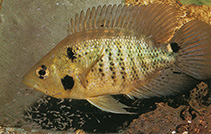| Family: |
Cichlidae (Cichlids), subfamily: Cichlinae |
| Max. size: |
26 cm SL (male/unsexed) |
| Environment: |
demersal; freshwater; pH range: 8.19999980926514 |
| Distribution: |
South America: Atrato, Cauca and Magdalena River basins and Lake Maracaibo basin in Colombia. Introduced in the Orinoco River drainage in Venezuela. |
| Diagnosis: |
Dorsal soft rays (total): 10-15; Anal spines: 5-6; Anal soft rays: 8-10. Body with dorsoventral bands; a black spot on the posterior region of the caudal peduncle, and another on the middle of the body, just below the lateral line (Ref. 26543). |
| Biology: |
Found in rivers, but prefers marshes or swamps abundant in aquatic plants (Ref. 26543). Feeds on other fishes and benthic invertebrates (Ref. 26543). Not common in the aquarium trade but occasionally imported (Ref. 12251). |
| IUCN Red List Status: |
Least Concern (LC); Date assessed: 15 January 2021 Ref. (130435)
|
| Threat to humans: |
harmless |
Source and more info: www.fishbase.org. For personal, classroom, and other internal use only. Not for publication.

